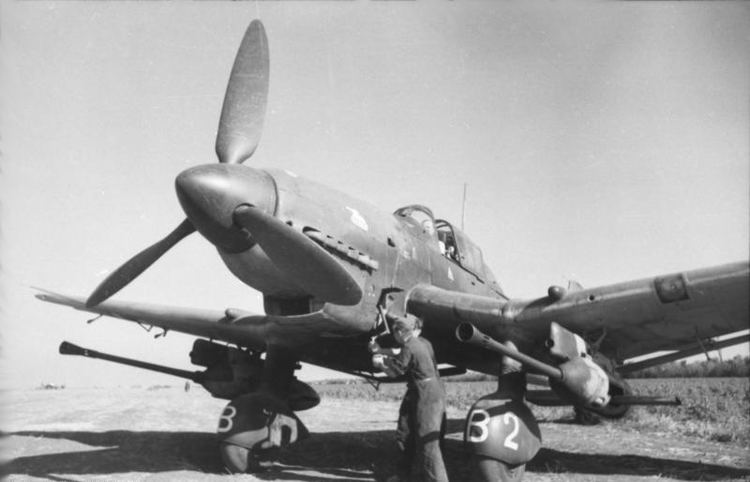Place of origin Germany Used by Axis powers | In service 1942-1945 Wars World War Two | |
 | ||
Type Aircraft mounted auto-cannon | ||
The Bordkanone 3,7 (BK 3,7) English: (on-)board cannon 3,7 was a 3.7 cm (1.46 in) anti-tank/bomber autocannon based on the earlier 3.7 cm (1.46 in) Flak 18 made by Rheinmetall. It was mounted on World War II Luftwaffe aircraft such as the anti-tank or bomber-destroyers: Junkers Ju 87 G-1 and G-2; Henschel Hs 129B-2/R3; Messerschmitt Bf 110G-2/R1-3; Junkers Ju 88P-2 / P-3 and others. The cannon could be attached under the wings or fuselage of the aircraft as self-contained gun pods with 12-round magazines. It fired APCR (Tungsten hard-core) ammunition or high-explosive shells in 37x263B mm caliber at 160 rounds per minute.
Service history
BK 3,7 equipped ground attack aircraft were developed for use in the anti-tank role on the Eastern Front in a somewhat desperate effort to blunt the massive numerical superiority of the Soviet T-34 as the war turned against Germany. The concept was rather rudimentary, suffered from various issues (primarily poor accuracy, severe weight penalty making the craft vulnerable to fighters, and a low ammunition capacity), but could be extremely effective when operated by a sufficiently skilled and practised ground-attack pilot (Hans-Ulrich Rudel in his BK 3,7 armed Junkers Ju 87G being the ultimate example).
The heavy-calibre auto-cannon-armed series of Junkers Ju 88P twin-engined attack/bomber destroyer aircraft series used twin BK 3,7 cannon, mounted side-by-side in a conformal ventral fuselage gun pod, in its Ju 88P-2 and P-3 versions. The P-3 version only differed through the addition of extra defensive armour. As with other examples of the P-series, the Ju 88P-2 and P-3 were perceived as failures in both anti-tank and bomber destroyer role.
In contrast to the previous method (bombs delivered by dive bombing), when the BK 3,7 was employed in a top attack profile against the especially thin upper turret and engine compartment armour of a tank, kills could be achieved with a relatively light and cheap armour-piercing projectile that could be carried in much greater quantities than bombs, but would be insufficient to penetrate if fired horizontally from the ground in the normal method.
One of the two surviving Junkers Ju 87s is a G-2 model displayed at the Royal Air Force Museum London. The aircraft's wings have the attachment points for BK 3,7 gun pods, but it is not displayed with them fitted.
